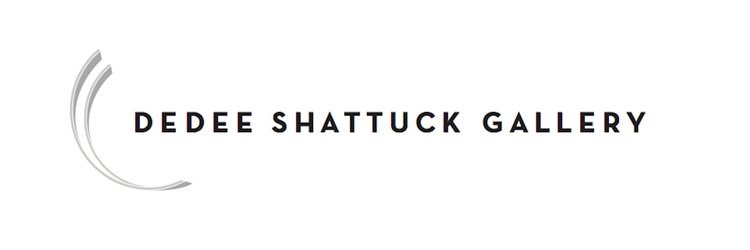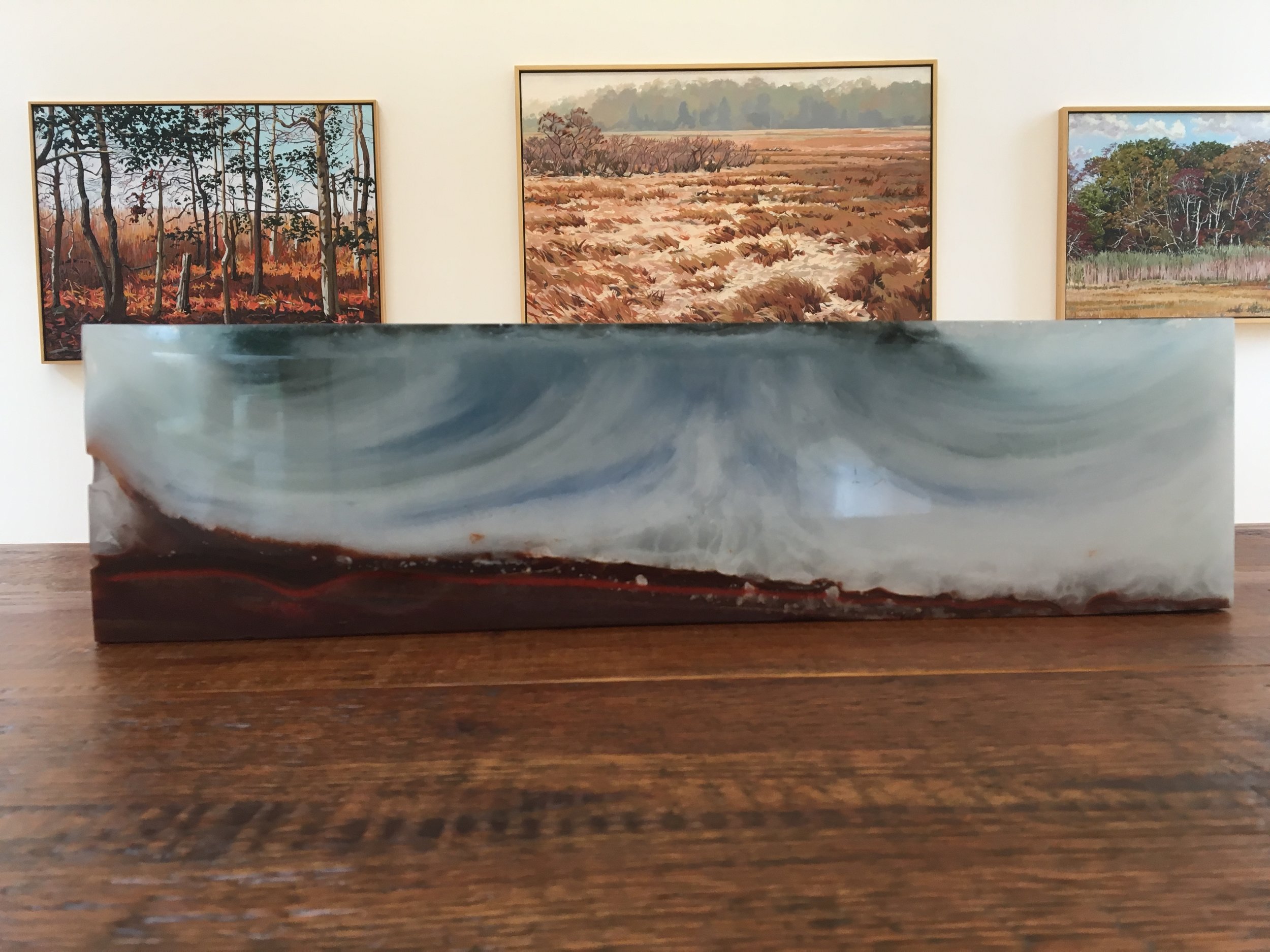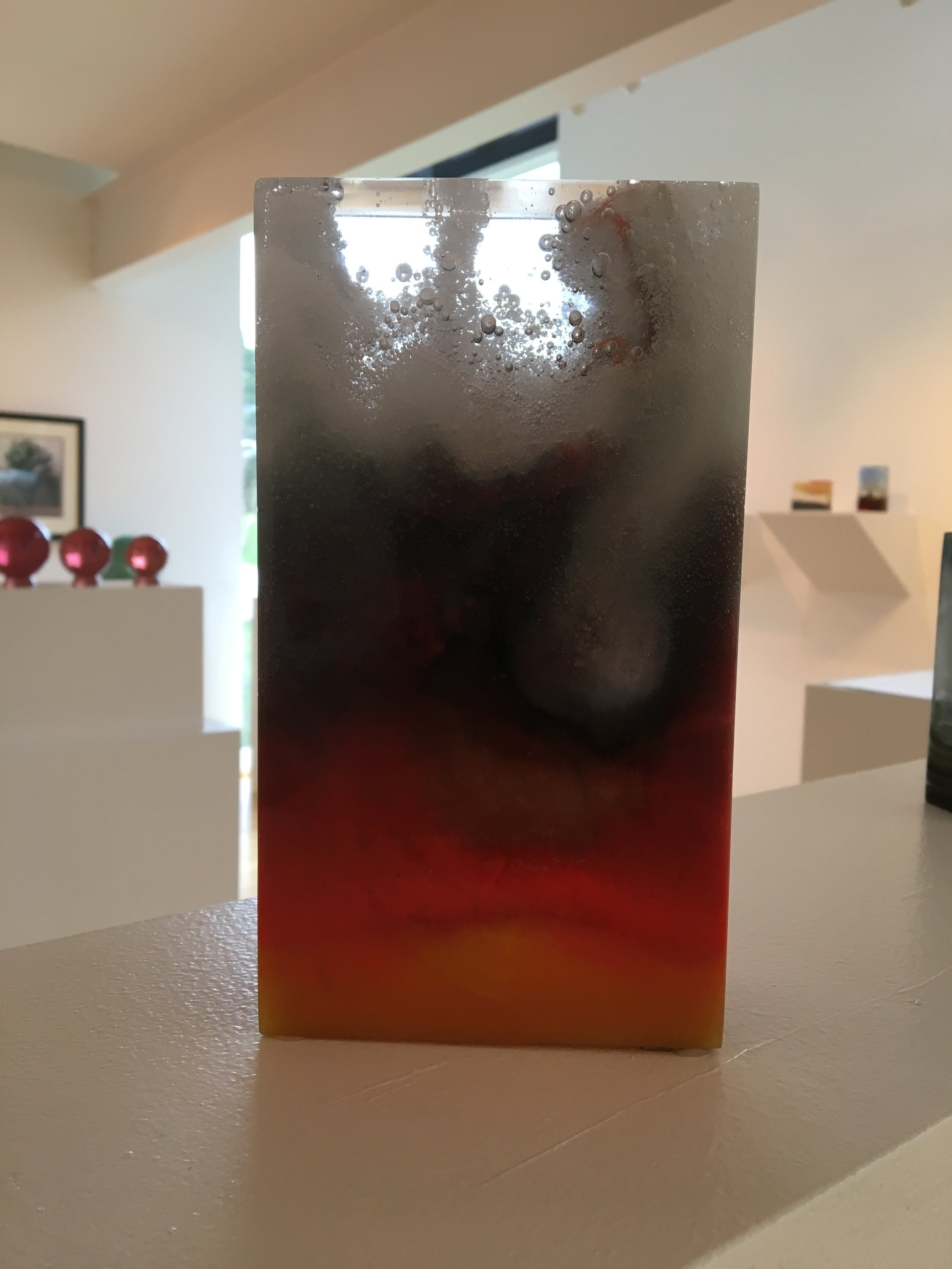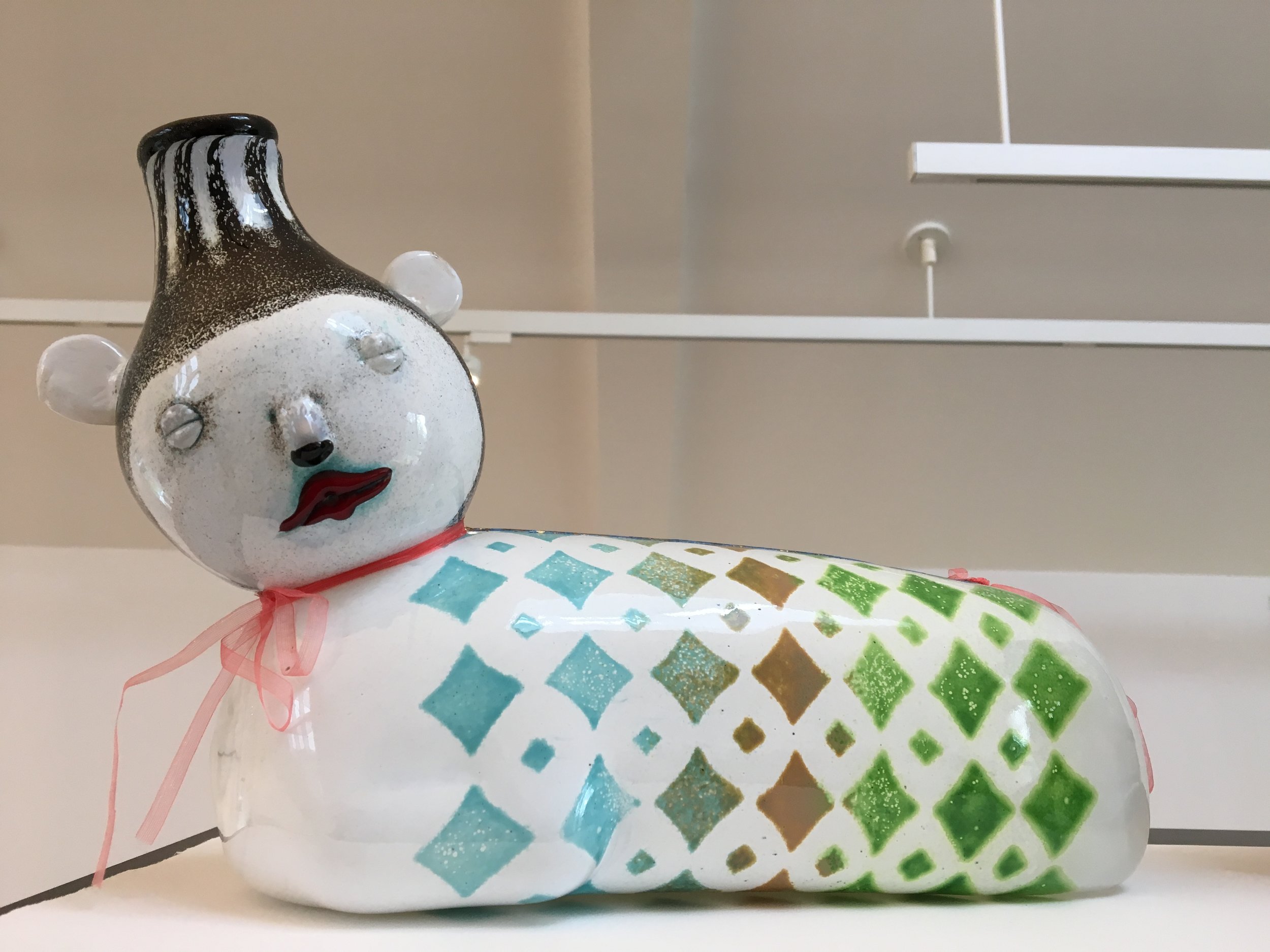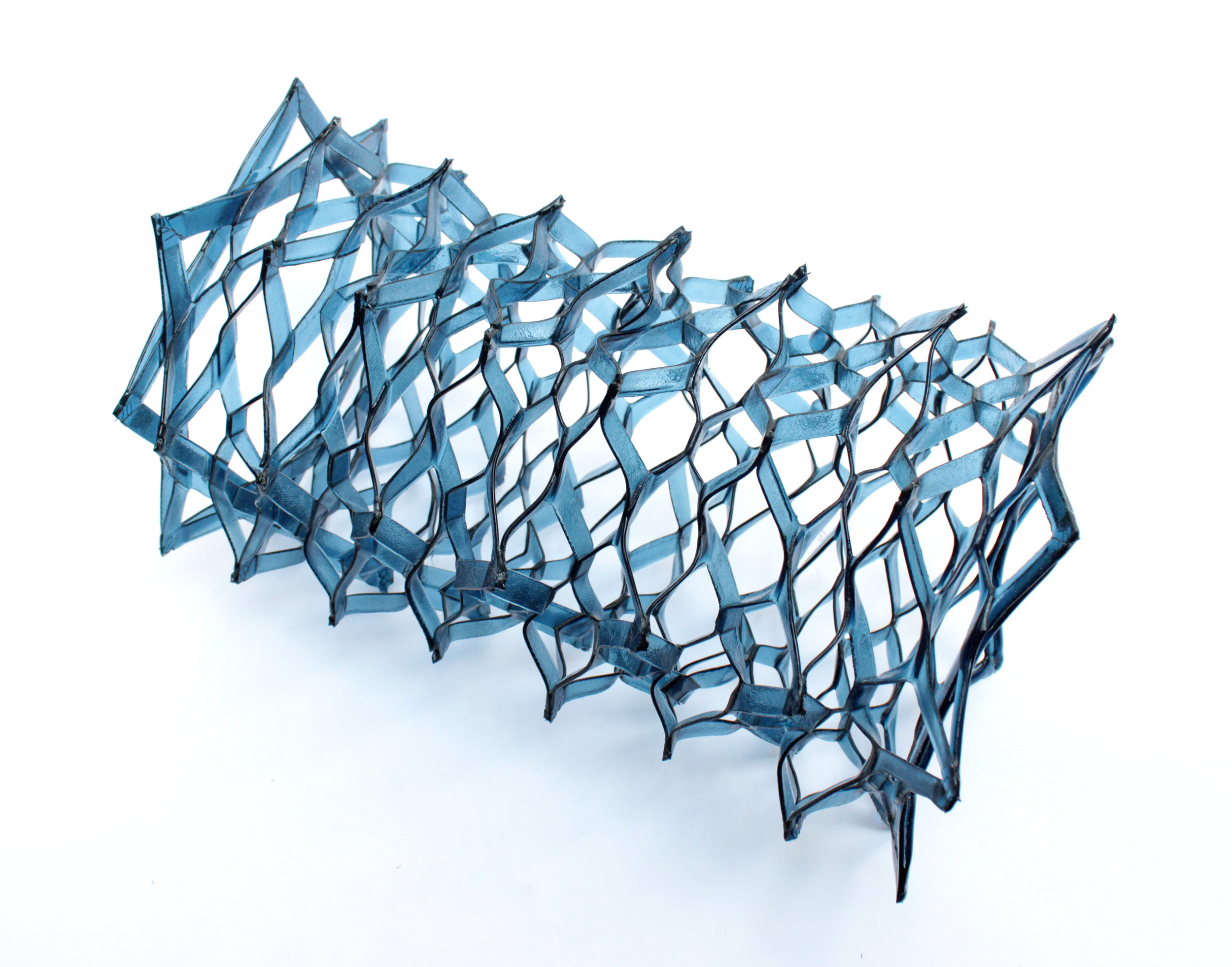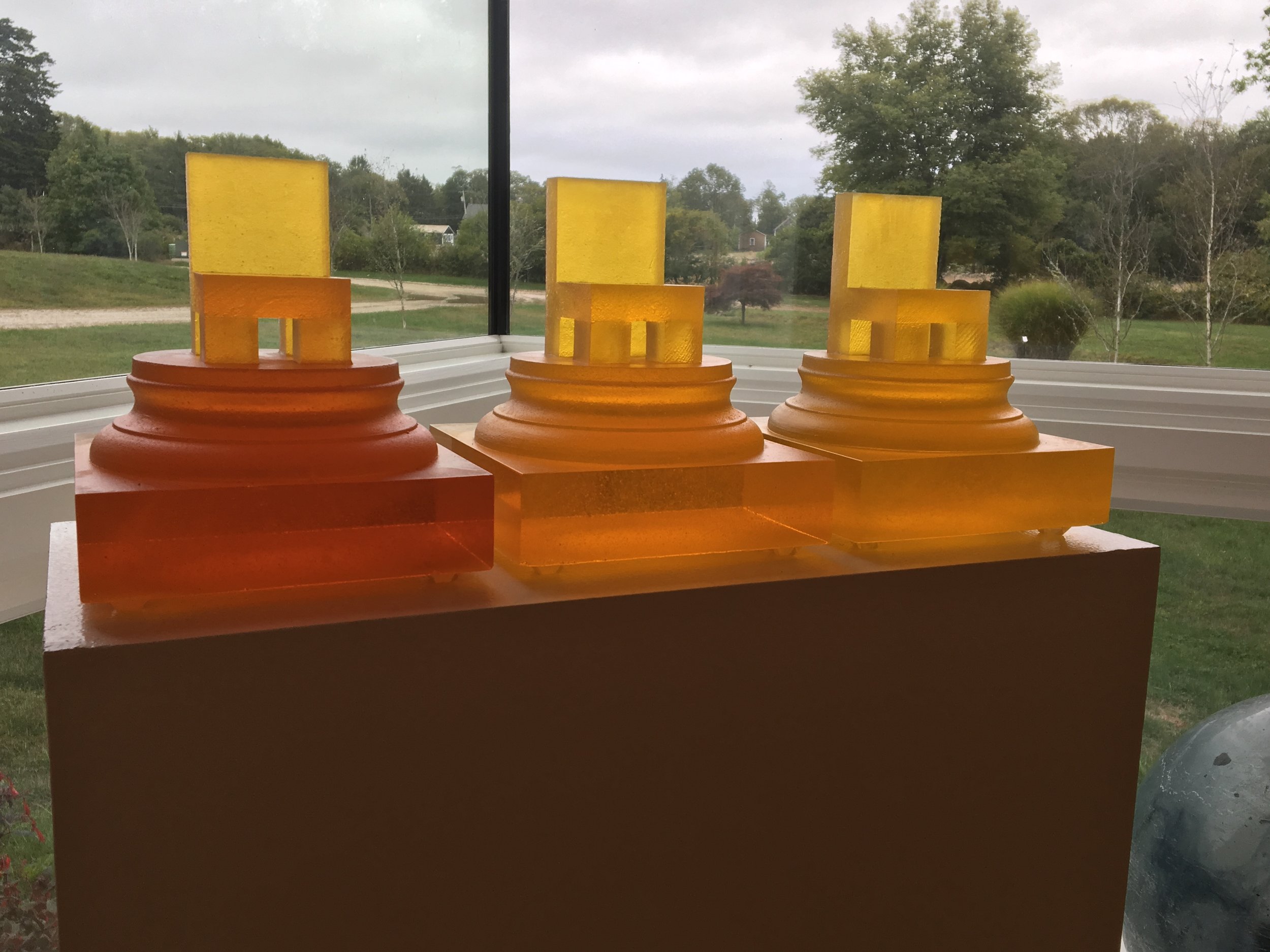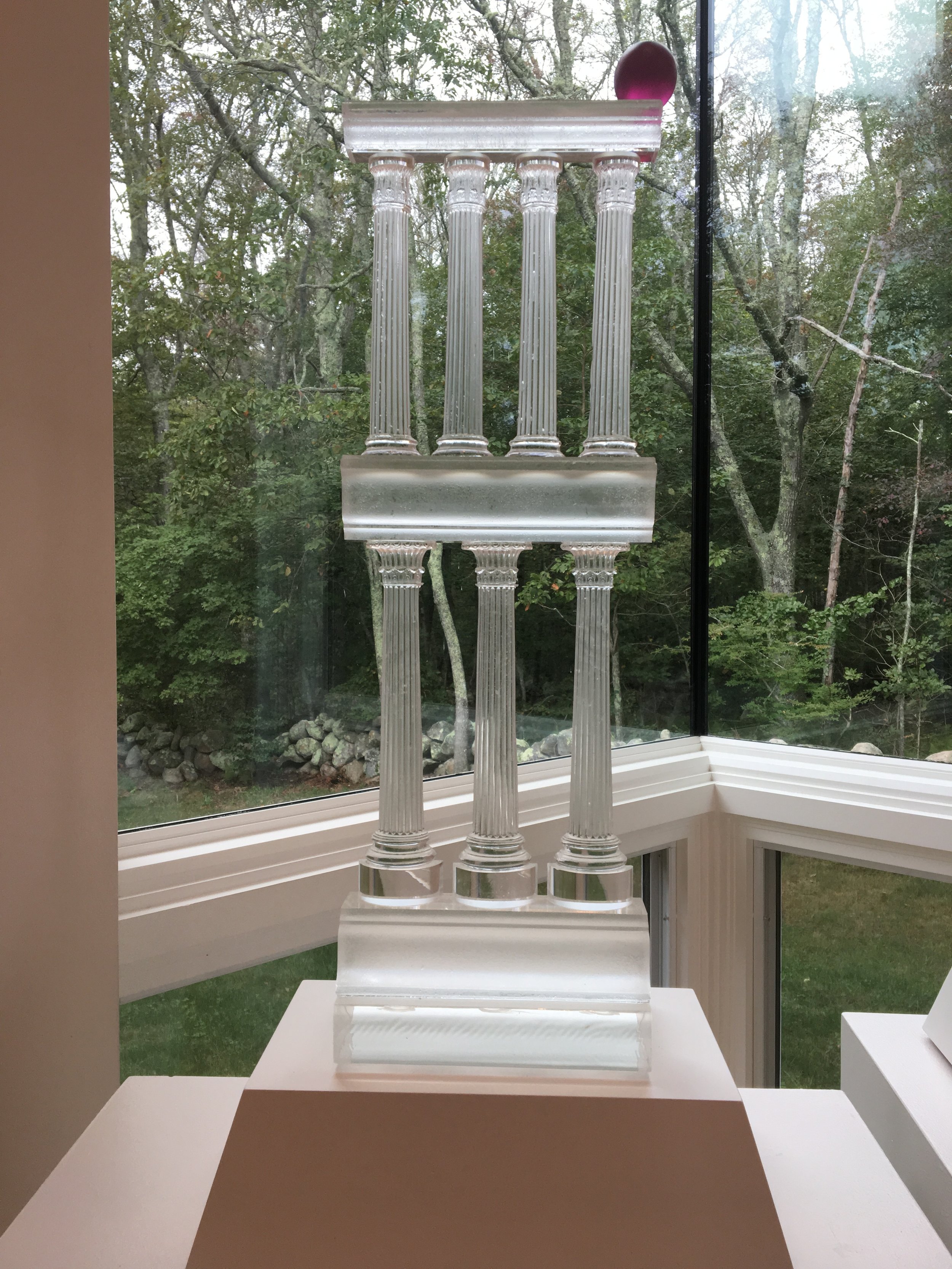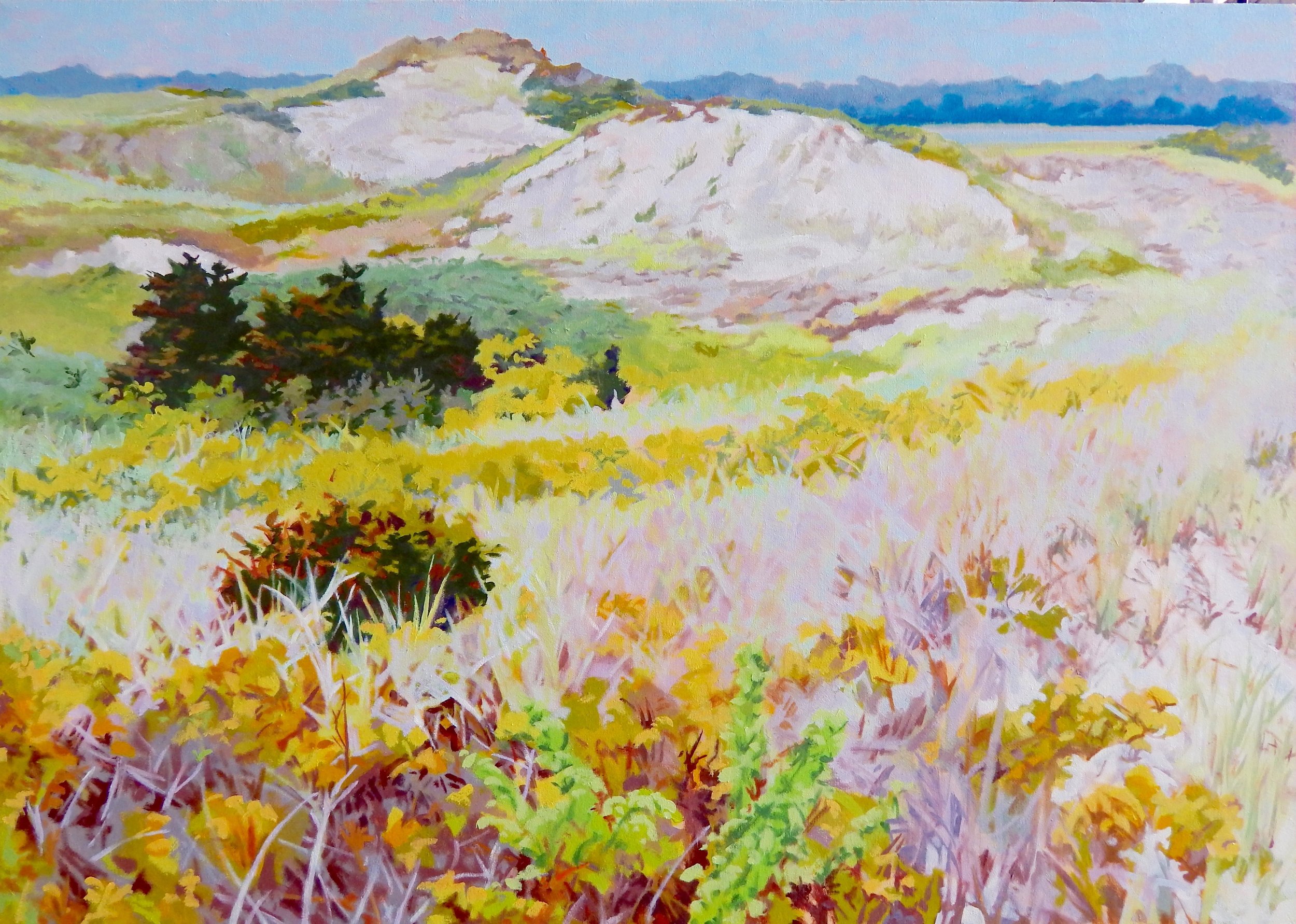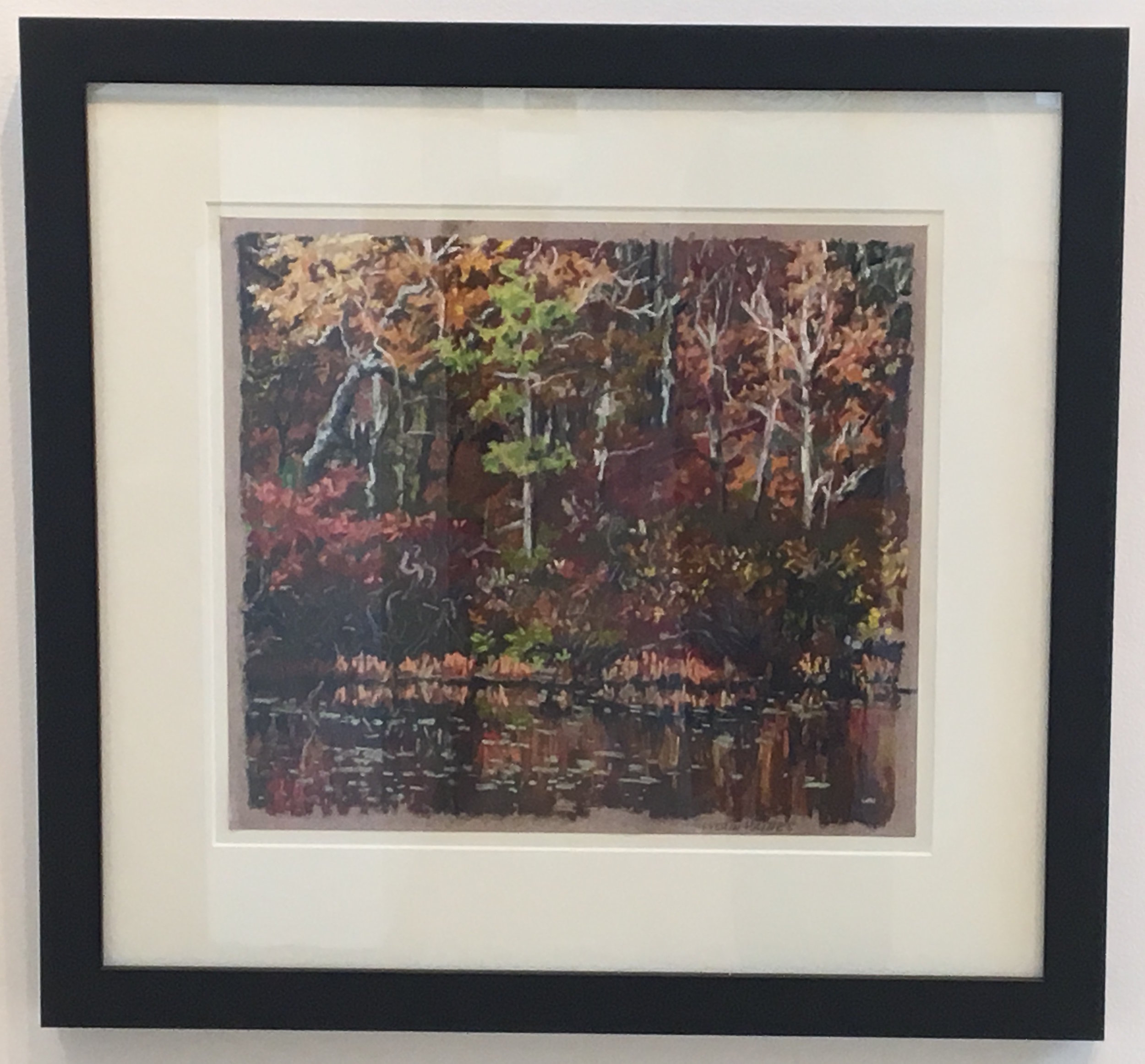Works in GLASS
with paintings by Severin Haines
September 28– November 6, 2016
Artists’ Reception:
Saturday, October 1, 5‐7pm
Dedee Shattuck Gallery is pleased to present Works in Glass, featuring KeKe Cribbs, Steven Easton, Adrianne Evans, Carrie Gustafson, Alicia Lomné, and Matthew Szösz, with paintings by Severin Haines. This exhibition will showcase a range of artists, whose works vary widely in theme and form. Artists explore pattern, surface, color, and light through various processes. Haines’s work includes his most recent stunning interpretations of the local landscape painted with oil, for which he is well known, and several intimate pastel studies. Exquisitely crafted glassworks include the dazzling, liquid‐like landscape constructions of Adrianne Evans and the pristine architectural forms of Steven Easton. Light and abundant color will dominate the gallery’s first glass‐focused exhibition
Adrianne Evans
There are many complex mechanisms at work to create the universe we live in. from my viewpoint, standing on the continental crust of the North American Plate I can see evidence of many of these systems. The mountain pass carved through stone reveal layers of silt that was worn away from somewhere far away that then settled to the bottom of some long gone body of water only to be shoved and folded and pressed into mounds thousands of feet high. And over time warm moist air traveling in from the coast, will be pushed up the slope of the mountainside to cooler temperatures where it will condense into rain clouds to begin the process again. In the cut earth I can see a tiny portion of the picture exposed and the rest of the story I must piece together in my imagination with the help of books and photographs.
I am very interested in the thin membrane we live in on the surface of the earth, sandwiched between miles of rock below us, and miles of atmosphere above. The world is so large and complex that I often feel I cannot grasp it all in the scale it exists in. By taking the processes that occur to shape the natural world and applying them to the way I work with glass, I am hoping to understand in a more tangible way, the manner in which things function.
Over the last several years I have been investigating ways of introducing glass into molds through the method of kiln casting by using the processes found in the natural world as an inspiration. By using glass as my medium and applying the same forces that shape our earth; erosion, grain sorting, friction, viscosity, flow, gravity, buoyancy, pressure, heat, and time, I am hoping to discover more about the mechanics of the physical world we inhabit. I am not looking to make a perfect miniature model of the world that actually exists, but rather use the mechanisms to get a view into moments that are usually hidden from our view because of scale, or access, or viewpoint.
I had been exploring a method in which I add powdered glass to a mold filled with water and let it settle to the bottom, creating layer after layer of sediment. Once fired at a varying range of temperatures the layers shrink and shift into distinctive geologic formations. I was also been experimenting with the creation of atmospheres. By combining different grain sizes of powders with a body of clear glass, I can capture clouds of microscopic bubbles in a similar way that tiny water particles cluster in the sky. Now I am combining these two methods to find that meeting place between the earth and sky.
Alicia Lomne
The first examples of Pate de Verre occur in Egyptian times, but it did not achieve popularity until the 19th century, when a small group of European artists was working within the form. These artists were very secretive, however, and many took their techniques with them to their graves. Similarly, while Pate de Verre has been popular in Japan, very little information has been recorded about the process, making it difficult for younger generations to employ the technique successfully.
Having always possessed a love of science, play, and discovery, I've thrilled at the opportunity to unravel the mysteries of Pate de Verre. From the beginning, I have used my work as a vehicle of exploration. When I first started in Pate de Verre, everything I made was about symmetry and a perceived perfection of form. I created symmetrical designs over the surfaces of uniform vessels. I cut and polished all my edges. As the work has evolved, it has also devolved, away from “perfection” to a more natural state of being. It has not always been easy to let go of my tendency to seek perfection; it has helped me greatly to look to the natural world, where perfection exists but often in less predictable or obvious ways.
Most of my pieces have two origins: a personal inspiration and an idea of process. My personal inspirations range from emotion, structure, connection, and being, to reflections of nature. A concept may spring from any place. When my daughter was much younger we played by balancing blocks on top of each other. It struck me that this is something most people have done; that there is an innate satisfaction in this activity. After that first experience with my daughter I created stacking pieces, which combined seven or eight glass vessels to form a type of totem. The idea of process in this instance was to create a method to cast the vessels with a hole in the bottom so they could later slide over a metal rod like a bead. Balance itself has become a common thread throughout much of my work.
Connection is also a theme I often explore. It is sometimes a literal connection, where two or more separate pieces join each other. The concept of connection grows through the work. The pieces have changed from more traditional vessel shapes to organic, even life-like objects. I am interested in reflecting what I see in nature and within the relationships between people. Often two separate forms, when in connection for a long period of time, will grow into and around each other, affecting one another's literal and figurative beings.
In recent years... To Read More Click Here
Carrie Gustafson
I am so fortunate that, as an artist, I am afforded the luxury of quiet every single day. The peace I receive from being in my studio is immeasurable. And working in my studio has become a critical component to calming my own nervous system. It’s only recently that I have realized just how important this time is to my own wellbeing. But what I have found even more remarkable is the effect my work, created in tranquility, has on others. That the pieces I craft with love, care and time do indeed shine serenity, light and joy back into the world.
My work is largely influenced by the natural world – plants, flowers, seeds, and most recently crystals – and I have come to view working in my studio akin to cultivating a garden. A daily routine which has become a critical component to my personal sense of balance, as well as an outlet for creative discovery. There is an organic rhythm to my creative process. Like an inhale and an exhale – inhaling my surroundings and exhaling life into new pieces. With each new piece another door for exploration opens. And I have found that each work uniquely informs the next; as much as anything external or pre-meditative.
A larger piece can take several weeks to complete and the seemingly simple act of hand cutting and applying stencils - one at a time – has lead to great discovery. Watching the growth of new patterns and the interplay of positive and negative space is a creative journey in itself. My love of color is always present and glass – magical and radiant; made by way of breath’s imprint – retains importance as metaphor in my work. Experiments in glassblowing while a printmaking major at Rhode Island School of Design (RISD) ignited my signature style of intricate patterns on vibrantly colored hand blown glass and I quickly found my way into the glass studio upon graduation. Studying glass at the Pilchuck Glass School (WA); Penland School of Crafts (NC); Studio at the Corning Museum of Glass (NY); the Rosin Studio, on Murano, Venice’s historic “glass island” in Italy.
For over a decade I worked with traditional vessels and I was captivated by the interplay that light, color, pattern and texture have with these closed forms. My career has gained credibility and recognition through seven Smithsonian Craft Show (2003 - 2013) as well as three Museum shows - The Bellevue Arts Museum (2006) The Fuller Craft Museum (2007) and, most recently, The Ebletoft Glass Museum (2016). In 2011 I was honored to be the recipient of a Massachusetts Cultural Council Grant. This, coupled with a residency at the Tacoma Museum of Glass, enabled me to embark on a new journey - breaking away from the vessel. The act of cutting open the vessels has presented me with a vast expanse of new possibilities and challenges, both technical and aesthetic. It has been a fascinating to witness just how different an “open” form reacts to light; this is an exciting new journey and potent metaphor for this stage in my life. Based on African currency bracelets this new format seemingly serves a dual purpose – for me a new way to see color and texture and light; and for the viewer, a fresh perspective. Perhaps due to the nature of the forms - which are reminiscent of artifacts and more easily identifiable with the pace of a museum – are seemingly more deserving of close observation – where as a vessel, which we identify as utilitarian, might more easily be overlooked.
KeKe Cribbs
Although primarily self-taught, I have taken classes at Pilchuck, Penland and Pratt where I have explored all the mediums and techniques in which I am interested, and which I use variously in my mixed media works. Reverse painting with vitreous enamels on sheet glass is my primary material, but I add my painted glass to sculptural works using ceramics, concrete, wood, metals, fabric, paper, printing, collage and painting. I use all these materials to follow my conceptual ideas which are more important than the material itself, but I love having the ability to craft with these materials in the spirit of a Renaissance artist who loves and understands the science of his materials. Exploration continues to be a driving force in my work and I love the challenge of the New.
About
KeKe Cribbs was born in 1951 in Colorado Springs, Colorado, the eldest daughter of five children. When KeKe was 15, her mother moved the family to Ireland to write her doctoral thesis on the poet Yeats. After three years KeKe traveled to Italy and France, eventually making a home on the island of Corsica where her daughter Alicia Lomne, also a glass artist, was born.
The art work of KeKe Cribbs has been very influenced by the places she has lived. The desert lands of the Southwest, which still have deep cultural roots for her, and architecture, threaded through with the experiences of living in old European villages with winding cobble streets, heavy iron locks and hinges on old wooden doors. There is a sense of mystery and adventure sewn with magic in her work; new lands with old stories. Her love ofthe highly crafted works from antiquity show in the way she handles her materials.
KeKe has had time to hone her craft to the ultimate height of technical perfection while retaining curiosity and conceptual intention. Her work is vibrant, colorful and sparkling with the many facets of reverse fired enamel mosaics which she makes for each piece. Her enameled paintings have a surrealistic dream quality which speaks to the mystery and joy of one's voyage through life. The other materials, whether they are painted wood, antiqued metals, sculptural concrete or ceramics, always feel like they have been around for centuries … new lands with old stories indeed!
Matthew Szosz
I am the child of two ideas. The first is the unreconstructed artisanship tradition in which I was raised. The second is the church of ecstatic blue collar Rock & Roll anarchy for which I volunteered. This is the territory that excites me- lying between the sensitive and considered restraint of learned technique and the manic populist energy of the rock throwing iconoclast, described by an urgent elliptical oscillation between the two. Sophisticated, erudite ideas with feet of clay, a heedless headlong dive into complex and esoteric waters. The friction of these two has been my experience of life, the experience of living within the body and the mind at the same time, each correcting the other in ragged arrhythmia. The opposing pulls of intellect and emotion maintain a tense center that lives and vibrates with their energy.
Steven Easton
My work is based on the belief that creativity is at the center of everything positive; thus, the creation of beauty functions both aesthetically and spiritually.
Key themes for me are the concept of treasure, the inward turning nature of psychoanalytic thought, and portraits as symbols that are immediate and personal, yet ancient. My artistic production is a fusion of myriad elements in an environment where the boundaries between art, science, and religion are blurred.
My inspiration comes from astronomical and miniature patterns; structures and proportions that appear in every size in nature, manifested in such forms as snowflakes, diatoms, crystals, eggs, and spheres. I am fascinated by the faces of people who once lived; deeply intrigued by the mystery of prior civilizations, world cultures, and classical antiquity.
Severin Haines
Dedeeshattuckgallery.com | 508. 636. 4177 | 1 Partners' Lane, Westport, MA 02790 | W - Sat, 10 - 5, Sun 12 - 5
